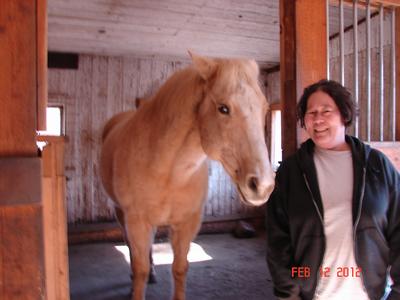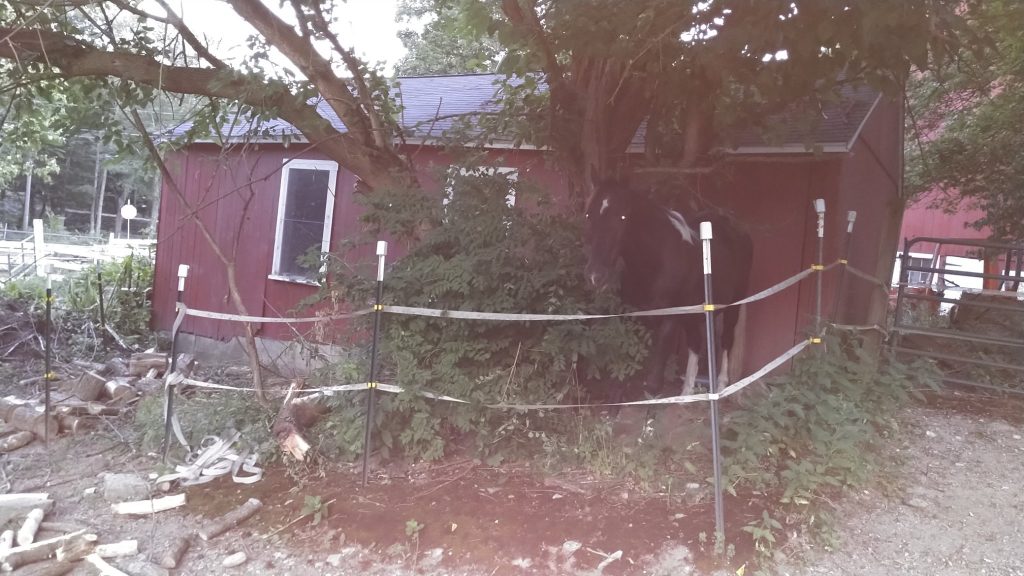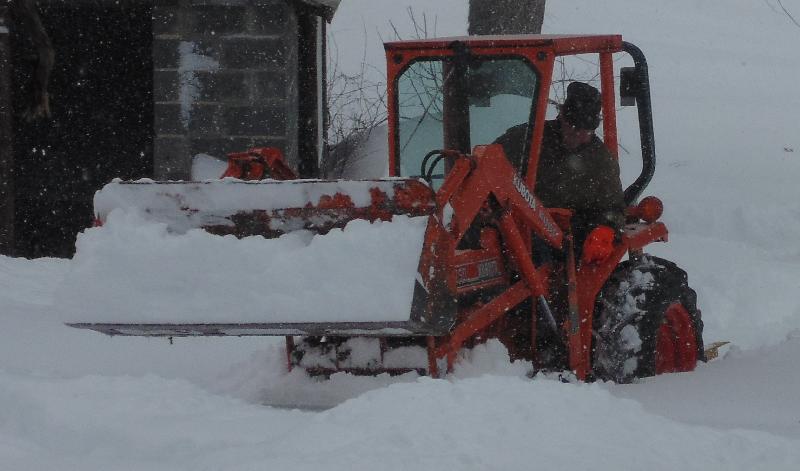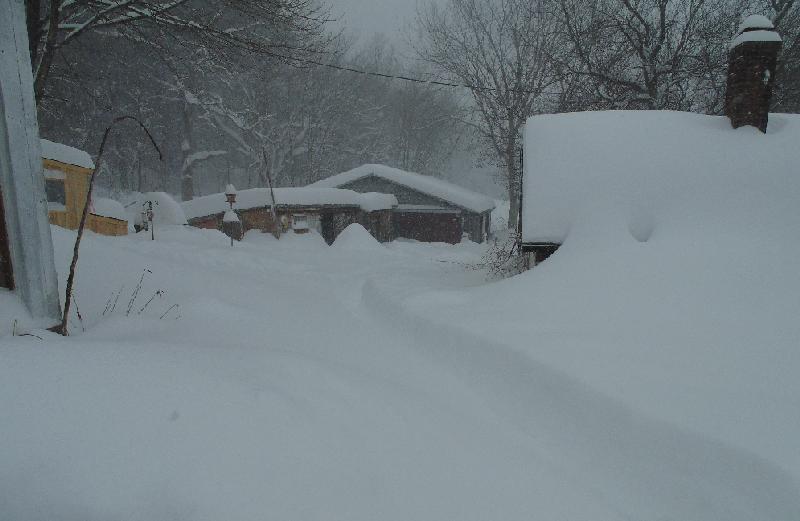

A few years ago, Cisco taught all of us an unforgettable lesson, one that’s still important on our farm today…
Cisco: “We had a tree crash down yesterday, right across our fence! Dusty says he wasn’t bothered, but I was spooked.”
Dusty: “It made a big noise, but I was brave. Cisco? Not so much!”
Cisco: “The fallen tree landed partly on our fence. Mom and Dad came out with noisy things to carve it into pieces. Once they finished, Dusty and I had a blast munching on bark, branches, and leaves.
“After dinner in the barn, we dashed back outside for more fun. Mom didn’t realize horses would snack on every part of that tree, but that’s what big teeth are for!
“We nibbled all night, hay, then tree, then hay again. Then I saw a tasty patch between that other building and the mulberry tree. I squeezed around for it… and suddenly I was stuck! Building on one side, tree on the other side, and fence all around. I couldn’t go forward or backward. Oh no, I was trapped!”
Dusty: “Hahaha! Cisco got himself stuck. More tree for me!”
Cisco: “I waited. It felt like forever. By morning, Mom came down for chores and greeted me but didn’t see I was trapped. I tried to keep calm, remembering what she’d taught me: If I don’t show up, she’ll always come looking.
“She called me. I couldn’t come, I was getting nervous and couldn’t even answer her! But I keep breathing and trusted she would come find out what was wrong.”
Dusty: “I tried to convince Mom you were just sleeping, but she knew better!”
Mom: “Not wanting breakfast is a very bad sign. I had to check out what happened.”
Cisco: “Soon, she spotted me caught behind the fence.


“She spoke gently: ‘Oh poor Cisco, what happened?’
“Mom took down the tape, talking softly as she worked so I wouldn’t panic. I held my nerves until she said, ‘Go ahead Cisco, nice and slow, you’re free!’
I dashed out, but only once she was safely out of the way, then trotted into the barn for breakfast, stiff but relieved!”
Dusty: “I nipped Cisco for making breakfast late, but he didn’t even bite back!”
Cisco: “I stayed close to the barn while Mom moved more tape so I wouldn’t get caught again. Later, she and Dad cleared the rest of the tree and fixed the fence right.”
Mom: “I’m proud of Cisco. Rather than panic and break the fence, or hurt himself, he stayed calm until help arrived. He must have been hungry and scared, but he waited. Even tough the “fence” (electric tape) was off, he respected it and didn’t touch it.
“Cisco might have been stuck all night. But he trusted that I’d come for him, just as I always do.”
Horses aren’t just “machines” for work or show ribbons. They’re living, thinking, emotional beings.
As prey animals they see dangers everywhere, and anything that blocks escape ups their anxiety. That’s why they’re “spooky” – it’s a survival instinct.
But with patience and training, they can learn to pause, think, and trust their humans, even in stressful moments.
Barnyard Tip:
Teach your horses patience. Show them to think before they act and reassure them that you’ll come if they’re in a bind. This kind of trust could save their lives.


The Art of the Winter Barn Path
November is here! Winter may not officially begin until December 21, but Old Man Winter doesn’t care about the calendar.
Here in South Central Massachusetts, snow hasn’t arrived yet (knock on that fence post!). Still, neighboring farms have already seen flakes, so the white stuff will soon be on its way.
Barnyard tip for today: Prevent dangerous ice by plowing, shoveling, and/or salting your paths as soon as snow falls, even if it’s just a fluffy two inches. Don’t wait for a sunny thaw or wishful thinking to clear them.
Why the urgency? Because animal chores don’t stop for snow, and your critters count on you 1000% for their care. In winter, you’re not just hauling feed and treats, you’re lugging water too, unless you’re lucky enough to have a frost-free hydrant.
Water is heavy. And unlike spilled grain, which is just annoying and costly, spilled water quickly freezes. Into ice.
Hard, smooth, slippery ice that turns routine chores into hazards. Worse, once it’s there, each cold night breeds even more ice, making it tougher to remove every day.
Here’s another tip: When you clear your paths, make them wider than you think you’ll need for your wheelbarrow, cart, or sled.
Why? Those wide paths you make now will shrink as the season wears on and you get tired of shoveling, or melting snow collapses them in. One day, your “plenty wide” paths will become narrow strips, and you’ll find yourself crab-walking with heavy pails.
So as the flakes start to fly, remember to clear those paths as wide as you can. It’ll make caring for your animals much safer and easier, even when Old Man Winter tries his best to slow you down.
Don’t let winter win – clear those paths and walk with confidence all season!
.
Product Spotlight: Yaktrax Slip-On Ice Cleats

Walking on ice can be treacherous, especially if you’re carrying grain or water! I’ve found these cleats to be the best!
Other pull-on cleats look like like tiny inverted thumb tacks, and they don’t work for me. These chain-like cleats don’t seem to slide or move around as badly.
Caution: All cleats are great on snow and ice, but mud sucks them down. Also be very careful on rubber stall mats, concrete, and especially linoleum. Cleats slide like sled tracks on these materials!
Click here to check them out!
Click to Read Previous Issues of This Newsletter
.
Click to Subscribe to This NewsletterYou can also subscribe by clicking on the “Subscribe” button on the top left of previous newsletters.
Interested in other newsletters?
Love what you read or want to help keep the lights on?
Click to Make a Voluntary DonationThis post contains affiliate links, which means I may earn a commission
if you click through and make a purchase through these links.
This post is intended for informational purposes only. All information provided does not constitute veterinary medical advice and should not be used as a replacement for professional veterinary consultation. I am not a veterinarian or any other medical professional. Please consult your veterinarian regarding any change in treatment or supplementation for your companion animal.
.
